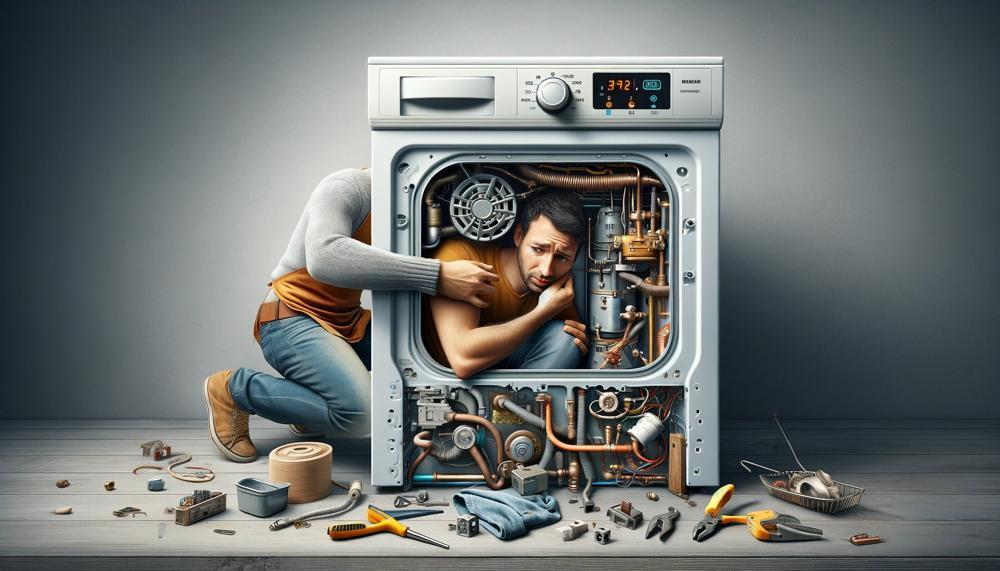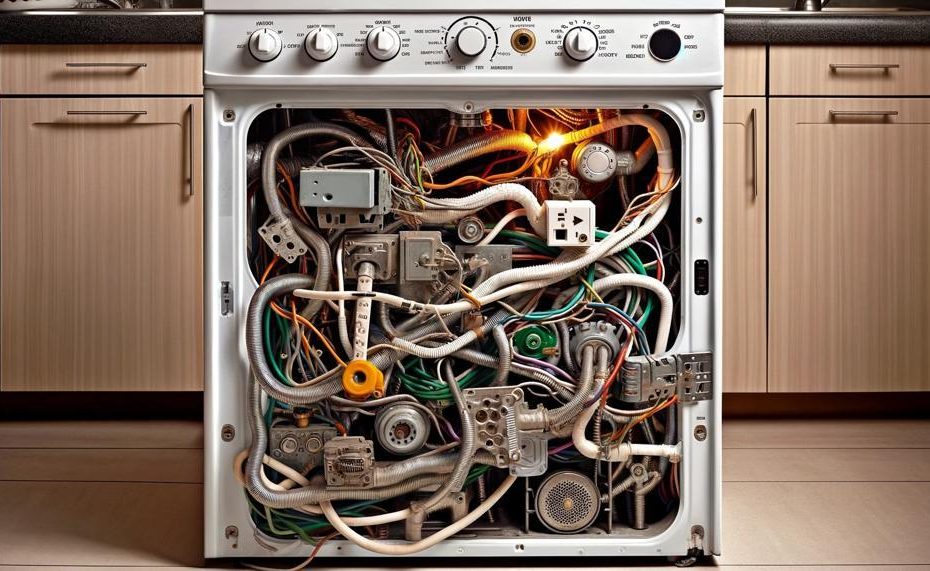Are you ready to part ways with your trusted gas dryer?
Whether you’re upgrading to a newer model or relocating to a new home, disconnecting your gas dryer is an essential step. But rest assured, it’s not as intimidating as it may seem.
With the right tools and some savvy techniques, you can have your gas dryer disconnected in a jiffy.
So, how to disconnect gas dryer?
The steps to disconnect a gas dryer are as follows:
- Close the gas valve. This valve is located directly in front of the dryer. Turn the handle until it is perpendicular to the pipe to turn it off. Additionally, you have the option to shut off the main gas supply valve to your home.
- Unscrew the flex hose from the gas line to disconnect the dryer from it. While holding the smaller fitting stationary, you may use a wrench to spin the larger fitting counterclockwise.
- Use a gas line cap to seal the gas line.
- To guarantee a perfect seal, encircle the connection with Teflon tape.
So grab your trusty toolbox and let’s get started.
Contents
Can I disconnect my gas dryer myself?
The satisfaction of completing a home improvement project without the help of professionals can be alluring. Yet, when it comes to gas appliances, such as a gas dryer, caution must be exercised. Safety should always be the top priority, and sometimes, it’s best to leave it to the experts.
Now, you may be wondering, can you disconnect your gas dryer yourself? The straightforward answer is yes, but there are vital considerations and steps to follow to ensure a safe and successful disconnection.
Firstly, it’s essential to note that in California, licensed professionals are required by law to handle any issues related to gas appliances. This is because an improper disconnection can result in gas leaks, posing significant fire and health hazards. However, if you are confident in your abilities and have the necessary tools and knowledge, here is a step-by-step guide on how to safely disconnect your gas dryer.
Step 1: Gather Your Tools
Before starting the disconnection process, make sure you have all the necessary tools on hand. These include a gas shut-off valve, a wrench or pliers, and Teflon tape.
Step 2: Locate the Gas Shut-Off Valve
The gas shut-off valve for your dryer should be found behind the appliance or in the basement near the gas meter. Turn the valve to the “off” position to stop the flow of gas to the dryer.
Step 3: Unplug Your Dryer
While it may seem obvious, it’s crucial to unplug your dryer from the electrical outlet before beginning any work.
Step 4: Disconnect the Gas Line
Using a wrench or pliers, carefully loosen and detach the flexible gas line from both the dryer and the shut-off valve. This step must be done slowly and carefully as there may still be residual gas in the line.
Why do I need to disconnect the gas dryer?
Gas dryers are efficient and dependable for drying clothes, but they require regular upkeep and may occasionally need to be disconnected for relocation or updates. However, handling gas appliances can be perilous, and it’s essential to exercise caution and use proper safety gear.
So why is it necessary to disconnect a gas dryer before any maintenance or repairs? Let’s delve deeper into the potential risks and how to safely disconnect your gas dryer.
Electrocution
One of the primary dangers of not disconnecting a gas dryer is the risk of electrocution.
Gas dryers run on electricity, and failing to disconnect the power supply before attempting any maintenance or repairs can result in severe injuries or even fatalities.
Gas Leaks
Another potential hazard is gas leaks. Gas dryers use natural gas or propane as fuel, and if the gas line is not properly shut off before disconnection, it can lead to a hazardous gas leak.
This can cause fire or explosion hazards, putting you and your home at great risk.
Appliance or Gas Line Damage
Trying to conduct maintenance or repairs on a gas dryer without disconnecting it can also cause damage to the appliance itself or the gas line.
The force of the repair or maintenance work may cause the appliance to shift or move, potentially damaging the gas line and causing leaks.
How to Safely Disconnect Your Gas Dryer
Now that we understand the potential hazards, let’s go through the step-by-step process for safely disconnecting a gas dryer.
Tools you need to disconnect the gas dryer
Whether you’re planning to perform maintenance or repairs on your gas dryer, or simply need to disconnect it for a move, it’s essential to know how to do so safely and correctly. One of the first steps in this process is gathering the necessary tools and equipment.
But don’t worry, you won’t need a whole toolbox for this task. In fact, there are only a few key tools that you will need. Let’s explore these tools and their importance in disconnecting a gas dryer.
Adjustable Wrench
An adjustable wrench is a versatile tool that allows you to loosen or tighten nuts and bolts of various sizes. It’s an essential tool for disconnecting a gas dryer, as it will be used to loosen and remove the nut connecting the gas line to the dryer.
Make sure to have an adjustable wrench that fits comfortably in your hand, for ease of use.
Screwdriver
Another crucial tool for disconnecting a gas dryer is a screwdriver. Depending on your specific dryer model, you may need either a Phillips or flathead screwdriver.
This tool will come in handy when removing screws from the dryer’s back panel or any other parts that may need to be disassembled.
Gas Shut-off Valve
When working with gas appliances, safety should always be a top priority. That’s why having a gas shut-off valve is crucial when disconnecting a gas dryer.
This valve is typically located near the appliance and allows you to turn off the gas supply in case of an emergency.

Gas Line Pliers
Gas line pliers are specifically designed for working with gas lines. They provide a secure grip and prevent damage to the gas line while disconnecting it from the dryer.
It’s crucial to use these pliers instead of regular pliers, as they help avoid potential gas leaks or damage.
How to disconnect a gas dryer?
The first step is to turn off the gas supply. This may seem like a no-brainer, but it is a crucial step that cannot be overlooked. As any expert will tell you, locating the shut-off valve behind the dryer and turning it off is essential for safety. This prevents any gas from flowing to the appliance and causing potential accidents.
Next, unplug the dryer from the electrical outlet. This eliminates any potential electrical hazards while working on disconnecting the gas line. Now comes the interesting part – disconnecting the gas line itself. This step requires a certain level of expertise, as one must use a wrench or pliers to carefully loosen and remove the flexible gas line from both the dryer and shut-off valve. One must also be mindful of any residual gas in the line and have a bucket or towel handy to catch any drips.
Now that the gas line is disconnected, it is time to move the dryer from its current location. This is where having an extra pair of hands comes in handy as dryers can be heavy and difficult to maneuver alone.
Once moved, remove any remaining screws or brackets that were holding the dryer in place.
Who can disconnect a gas dryer?
With the complexities of dealing with gas lines and potential safety hazards, it is best to leave this task to the professionals. But who exactly is qualified to handle such a job? And why is it crucial to call in an expert?
It is highly advised to seek professional assistance when it comes to disconnecting your gas dryer. This includes licensed plumbers or heating service technicians who have undergone specialized training and possess ample experience in handling gas lines and appliances.
So why should you call a professional instead of attempting to do it yourself? For starters, removing a gas line requires great caution and expertise. It involves turning off the gas supply and carefully disconnecting the line, which can be dangerous if not done correctly. A small mistake can lead to gas leaks or other safety hazards that could put you and your home at risk. Moreover, relocating gas valves may require obtaining a permit, which only professionals who are familiar with local regulations can do.
When it comes to disconnecting a gas dryer, licensed plumbers or heating service technicians are the go-to experts. They possess the necessary skills, tools, and knowledge to handle gas lines and appliances safely and efficiently. They are also well-versed in local regulations, ensuring that all necessary permits are obtained for the relocation of gas valves.
While there may not be a certification specifically for de-commissioning gas-fired appliances, it is crucial to ensure that all associated works are carried out by a Gas Safe engineer in a safe manner. This guarantees that the process is completed correctly and without any potential risks.
Cost to disconnect the gas dryer
Are you looking to upgrade your laundry room or simply relocate your gas dryer? If so, the cost of disconnecting and capping off the gas line may be on your mind. While it may be tempting to save money by attempting this task yourself, it’s important to understand the complexities and risks involved.
Here, we’ll explore the intricacies of disconnecting and capping off a gas dryer and why hiring a professional is the most prudent decision.
The Cost Breakdown
Our research shows that the average cost for disconnecting and capping off gas from a dryer is approximately $This fee typically includes both labor and materials required for the job. However, this cost may vary depending on your location and specific circumstances.
To obtain an accurate estimate, it’s best to consult with a licensed plumber or heating service technician.
Why Hire a Professional?
Handling gas lines and appliances is not a job for amateurs. It requires specialized training and experience that only professionals possess. Attempting to disconnect your gas dryer on your own can lead to serious hazards, such as gas leaks and potential fires.
Additionally, obtaining permits for relocating gas valves can only be done by those familiar with local regulations.
The Dangers of DIY
Removing a gas line may appear to be a straightforward task, but it’s far from it. It involves shutting off the gas supply, carefully disconnecting the line, and properly capping it off to prevent any leaks.
This process requires expert knowledge and specialized tools that only professionals have. Moreover, there may be hidden complexities, such as rusty or corroded pipes, that could pose serious dangers if not handled correctly.
Entrust the Professionals
Entrusting professionals with disconnecting your gas dryer is undoubtedly the safest and most efficient option.
Conclusion
In conclusion, disconnecting a gas dryer may seem like a daunting task, but with the right tools and knowledge, it can be done safely and efficiently. However, safety should always be the top priority when dealing with gas appliances. This means taking necessary precautions such as wearing protective gear, turning off the gas supply and power, and ensuring proper ventilation in the area.
While it is possible to handle this task on your own, it is highly recommended to seek professional assistance. Licensed plumbers or heating service technicians have the expertise and experience to safely handle gas lines and appliances. Attempting to do it yourself can lead to potential hazards such as gas leaks or even electrocution.
It’s understandable that hiring a professional may come at a cost, but the peace of mind knowing that the job was done correctly and without any risks is priceless. So whether you’re upgrading your dryer or moving to a new home, entrust the task of disconnecting your gas dryer to the experts. After all, safety should always come first.





